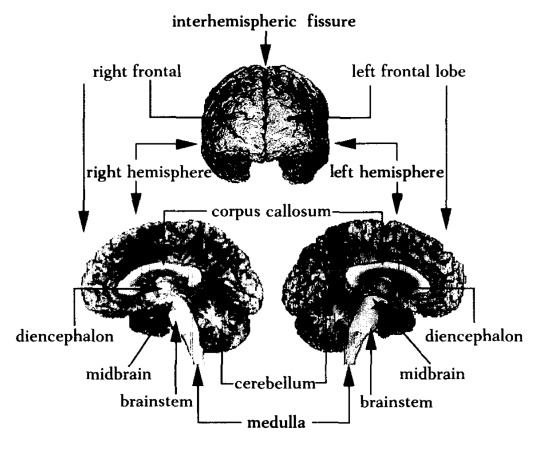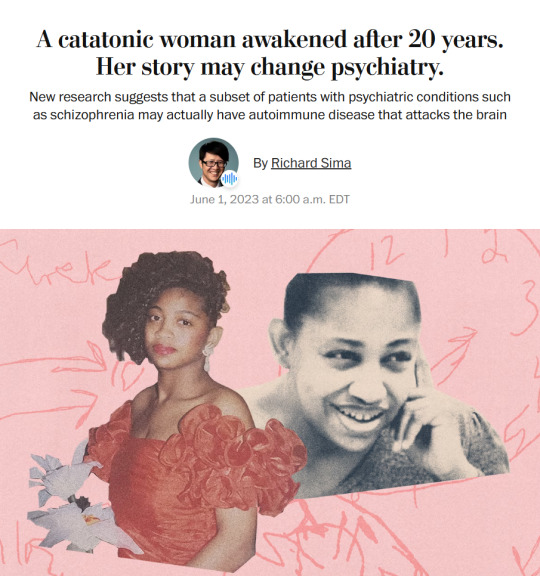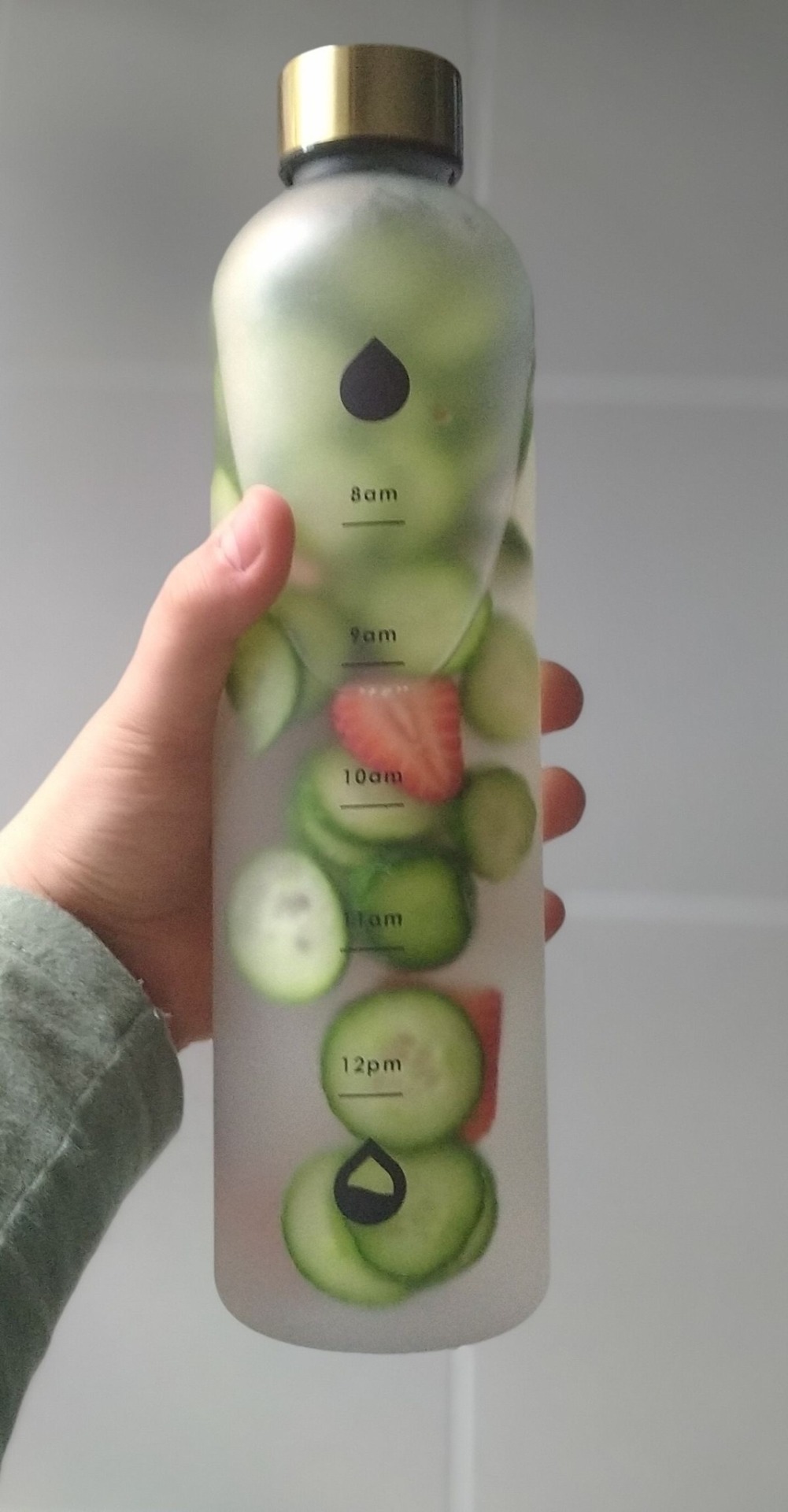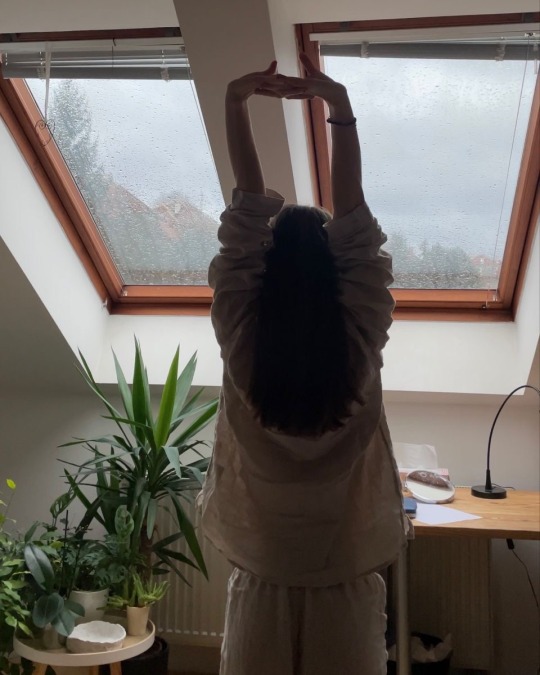#NeuroScience
Explore tagged Tumblr posts
Text
I have a certain amount of admiration for cognitive scientists who are prepared to cut the Gordian knot of defining what a mind is and simply deny the validity of their own subjective experience. I mean, obviously someone who looks you in the eye and says "I'm not actually conscious, I just behave as though I am" is full of shit, but you've gotta respect the audacity.
3K notes
·
View notes
Text
I'm still working up the courage to ask my mum if I can get tested because this is a genuine part of my day to day life, and my school psychologist said it might be a good idea. I live the way you wrote this btw!! It's awesome!!!
growing up autistic / growing up gaslit
I.
this is the first lesson you learn: you are always wrong.
there is no electric hum buzzing through the air. there is no stinging bite to the sweetness of the mango. there is no bitter metallic tang to the water.
there is no cruelty in their laughter, no ambiguity in the instructions, no reason to be upset. there is no bitter aftertaste to your sweet tea, nothing scratchy about your blanket.
the lamps glow steadily. they do not falter.
II.
this is the second lesson you learn: you are never right.
you are childish, gullible, overly prone to tears. you are pedantic, combative, deliberately obtuse. you are lazy, unreliable, never on time.
you’re always making up excuses, rudely interrupting, stepping on people’s shoes. you’re always trying to get attention, never thinking about anyone else, selfish through and through.
it’s you that’s the problem. the lamps are fine.
III.
this is the third lesson you learn: you must always give in.
mother knows best. father knows best. doctor knows best. teacher knows best. this is the proper path. do not go astray.
listen to your elders, respect your betters, accept what’s given to you as your due. bow to the wisdom of experience, the education of the professional, the clarity of an external point of view.
what do you know about lamps, anyway?
#autism#neurodivergent#neurodiversity#neuroscience#goddddddddddddddddddddddd#adhd brain#brainhealth#disability
30K notes
·
View notes
Text

Antonio Damasio, Descarte's Error: Emotion, Reason, and the Human Brain
412 notes
·
View notes
Text
34 REASONS TO HEAL
1. To heal your ancestors.
2. To heal others.
3. To lessen your physical pain.
4. To decrease worry.
5. To walk around with less baggage.
6. To become better at relationships.
7. To experience more life satisfaction.
8. To lessen your lack of presence in your own life.
9. To breathe easier.
10. To give your soul a break.
11. To get what you deserve in life.
12. To feel what inner peace feels like.
13. To break cycles.
14. To honor your community.
15. To reclaim your time.
16. To ensure that your abuser doesn't rob you of peace any longer.
17. To extend your positive energies.
18. To receive good vibes.
19. To internalize affirmations.
20. To extend your life.
21. To manage stress better than before.
22. To love more.
23. To be more honest with yourself.
24. To achieve those goals you've been holding onto.
25. To increase your creativity.
26. To heal your children.
27. To learn about your trauma.
28. To see firsthand how healing works.
29. To see yourself smiling more.
30. To improve your overall functioning.
31. To reclaim your mind, body & soul.
32. To lessen the burden you carry.
33. To hurt less.
34. To turn sadness into joy & light.
#quotes#positivity#inspiration#self care#self love#self worth#mental health#psychology#neuroscience#studyblr#studyspo#becoming that girl#becoming her#it girl#introvert#dark academia#self growth#personal growth#personal development#college#student#levelling up#self improvement#motivation#study motivation#txt#healing#self esteem#self confidence#self help
291 notes
·
View notes
Text
why neuroscience is cool
space & the brain are like the two final frontiers
we know just enough to know we know nothing
there are radically new theories all. the. time. and even just in my research assistant work i've been able to meet with, talk to, and work with the people making them
it's such a philosophical science
potential to do a lot of good in fighting neurological diseases
things like BCI (brain computer interface) and OI (organoid intelligence) are soooooo new and anyone's game - motivation to study hard and be successful so i can take back my field from elon musk
machine learning is going to rapidly increase neuroscience progress i promise you. we get so caught up in AI stealing jobs but yes please steal my job of manually analyzing fMRI scans please i would much prefer to work on the science PLUS computational simulations will soon >>> animal testing to make all drug testing safer and more ethical !! we love ethical AI <3
collab with...everyone under the sun - psychologists, philosophers, ethicists, physicists, molecular biologists, chemists, drug development, machine learning, traditional computing, business, history, education, literally try to name a field we don't work with
it's the brain eeeeee
#my motivation to study so i can be a cool neuroscientist#science#women in stem#academia#stem#stemblr#studyblr#neuroscience#stem romanticism#brain#psychology#machine learning#AI#brain computer interface#organoid intelligence#motivation#positivity#science positivity#cogsci#cognitive science
2K notes
·
View notes
Text

#neurology#neuroscience#psychiatry#psychology#brain function#brain research#brain activity#anatomical illustration#dark academia#brain imaging#weirdcore#dreamcore#cybercore#techcore
79 notes
·
View notes
Text
"[Character] has the brain cell."
Yes, they do have the brain cell, but unfortunately, the singular brain cell that they possess is an astrocyte, the most common type of brain cell, and not a neuron.
Astrocytes play a role in the structural support of neurons and maintaining a healthy balance of neurotransmitters, so that character's singular brain cell is simply there for support. It isn't actually there to do any thinking.
#this has been your fun biology fact for the day#science#neuroscience#science side of tumblr#brain cells
183 notes
·
View notes
Text
The exact nature of long COVID is still coming to light, but we just got some of the best evidence yet that this debilitating condition stems from a brain injury. Using high-resolution scanners, researchers at the Universities of Cambridge and Oxford have shown microscopic, structural abnormalities in the brainstems of those recovering from COVID-19. Signs of brain inflammation were present up to 18 months after first contracting the SARS-CoV-2 virus.
Continue Reading.
1K notes
·
View notes
Text

Story from the Washington Post here, non-paywall version here.
Washington Post stop blocking linksharing and shit challenge.
"The young woman was catatonic, stuck at the nurses’ station — unmoving, unblinking and unknowing of where or who she was.
Her name was April Burrell.
Before she became a patient, April had been an outgoing, straight-A student majoring in accounting at the University of Maryland Eastern Shore. But after a traumatic event when she was 21, April suddenly developed psychosis and became lost in a constant state of visual and auditory hallucinations. The former high school valedictorian could no longer communicate, bathe or take care of herself.
April was diagnosed with a severe form of schizophrenia, an often devastating mental illness that affects approximately 1 percent of the global population and can drastically impair how patients behave and perceive reality.
“She was the first person I ever saw as a patient,” said Sander Markx, director of precision psychiatry at Columbia University, who was still a medical student in 2000 when he first encountered April. “She is, to this day, the sickest patient I’ve ever seen.” ...
It would be nearly two decades before their paths crossed again. But in 2018, another chance encounter led to several medical discoveries...
Markx and his colleagues discovered that although April’s illness was clinically indistinguishable from schizophrenia, she also had lupus, an underlying and treatable autoimmune condition that was attacking her brain.
After months of targeted treatments [for lupus] �� and more than two decades trapped in her mind — April woke up.
The awakening of April — and the successful treatment of other people with similar conditions — now stand to transform care for some of psychiatry’s sickest patients, many of whom are languishing in mental institutions.
Researchers working with the New York state mental health-care system have identified about 200 patients with autoimmune diseases, some institutionalized for years, who may be helped by the discovery.
And scientists around the world, including Germany and Britain, are conducting similar research, finding that underlying autoimmune and inflammatory processes may be more common in patients with a variety of psychiatric syndromes than previously believed.
Although the current research probably will help only a small subset of patients, the impact of the work is already beginning to reshape the practice of psychiatry and the way many cases of mental illness are diagnosed and treated.
“These are the forgotten souls,” said Markx. “We’re not just improving the lives of these people, but we’re bringing them back from a place that I didn’t think they could come back from.” ...
Waking up after two decades
The medical team set to work counteracting April’s rampaging immune system and started April on an intensive immunotherapy treatment for neuropsychiatric lupus...
The regimen is grueling, requiring a month-long break between each of the six rounds to allow the immune system to recover. But April started showing signs of improvement almost immediately...
A joyful reunion
“I’ve always wanted my sister to get back to who she was,” Guy Burrell said.
In 2020, April was deemed mentally competent to discharge herself from the psychiatric hospital where she had lived for nearly two decades, and she moved to a rehabilitation center...
Because of visiting restrictions related to covid, the family’s face-to-face reunion with April was delayed until last year. April’s brother, sister-in-law and their kids were finally able to visit her at a rehabilitation center, and the occasion was tearful and joyous.
“When she came in there, you would’ve thought she was a brand-new person,” Guy Burrell said. “She knew all of us, remembered different stuff from back when she was a child.” ...
The family felt as if they’d witnessed a miracle.
“She was hugging me, she was holding my hand,” Guy Burrell said. “You might as well have thrown a parade because we were so happy, because we hadn’t seen her like that in, like, forever.”
“It was like she came home,” Markx said. “We never thought that was possible.”
...After April’s unexpected recovery, the medical team put out an alert to the hospital system to identify any patients with antibody markers for autoimmune disease. A few months later, Anca Askanase, a rheumatologist and director of the Columbia Lupus Center,who had been on April’s treatment team, approached Markx. “I think we found our girl,” she said.
Bringing back Devine
When Devine Cruz was 9, she began to hear voices. At first, the voices fought with one another. But as she grew older, the voices would talk about her, [and over the years, things got worse].
For more than a decade, the young woman moved in and out of hospitals for treatment. Her symptoms included visual and auditory hallucinations, as well as delusions that prevented her from living a normal life.
Devine was eventually diagnosed with schizoaffective disorder, which can result in symptoms of both schizophrenia and bipolar disorder. She also was diagnosed with intellectual disability.
She was on a laundry list of drugs — two antipsychotic medications, lithium, clonazepam, Ativan and benztropine — that came with a litany of side effects but didn’t resolve all her symptoms...
She also had lupus, which she had been diagnosed with when she was about 14, although doctors had never made a connection between the disease and her mental health...
Last August, the medical team prescribed monthly immunosuppressive infusions of corticosteroids and chemotherapy drugs, a regime similar to what April had been given a few years prior. By October, there were already dramatic signs of improvement.
“She was like ‘Yeah, I gotta go,’” Markx said. “‘Like, I’ve been missing out.’”
After several treatments, Devine began developing awareness that the voices in her head were different from real voices, a sign that she was reconnecting with reality. She finished her sixth and final round of infusions in January.
In March, she was well enough to meet with a reporter. “I feel like I’m already better,” Devine said during a conversation in Markx’s office at the New York State Psychiatric Institute, where she was treated. “I feel myself being a person that I was supposed to be my whole entire life.” ...
Her recovery is remarkable for several reasons, her doctors said. The voices and visions have stopped. And she no longer meets the diagnostic criteria for either schizoaffective disorder or intellectual disability, Markx said...
Today, Devine lives with her mother and is leading a more active and engaged life. She helps her mother cook, goes to the grocery store and navigates public transportation to keep her appointments. She is even babysitting her siblings’ young children — listening to music, taking them to the park or watching “Frozen 2” — responsibilities her family never would have entrusted her with before her recovery.
Expanding the search for more patients
While it is likely that only a subset of people diagnosed with schizophrenia and psychotic disorders have an underlying autoimmune condition, Markx and other doctors believe there are probably many more patients whose psychiatric conditions are caused or exacerbated by autoimmune issues...
The cases of April and Devine also helped inspire the development of the SNF Center for Precision Psychiatry and Mental Health at Columbia, which was named for the Stavros Niarchos Foundation, which awarded it a $75 million grant in April. The goal of the center is to develop new treatments based on specific genetic and autoimmune causes of psychiatric illness, said Joseph Gogos, co-director of the SNF Center.
Markx said he has begun care and treatment on about 40 patients since the SNF Center opened. The SNF Center is working with the New York State Office of Mental Health, which oversees one of the largest public mental health systems in America, to conduct whole genome sequencing and autoimmunity screening on inpatients at long-term facilities.
For “the most disabled, the sickest of the sick, even if we can help just a small fraction of them, by doing these detailed analyses, that’s worth something,” said Thomas Smith, chief medical officer for the New York State Office of Mental Health. “You’re helping save someone’s life, get them out of the hospital, have them live in the community, go home.”
Discussions are underway to extend the search to the 20,000 outpatients in the New York state system as well. Serious psychiatric disorders, like schizophrenia, are more likely to be undertreated in underprivileged groups. And autoimmune disorders like lupus disproportionately affect women and people of color with more severity.
Changing psychiatric care
How many people ultimately will be helped by the research remains a subject of debate in the scientific community. But the research has spurred excitement about the potential to better understand what is going on in the brain during serious mental illness...
Emerging research has implicated inflammation and immunological dysfunction as potential players in a variety of neuropsychiatric conditions, including schizophrenia, depression and autism.
“It opens new treatment possibilities to patients that used to be treated very differently,” said Ludger Tebartz van Elst, a professor of psychiatry and psychotherapy at University Medical Clinic Freiburg in Germany.
In one study, published last year in Molecular Psychiatry, Tebartz van Elst and his colleagues identified 91 psychiatric patients with suspected autoimmune diseases, and reported that immunotherapies benefited the majority of them.
Belinda Lennox, head of the psychiatry department at the University of Oxford, is enrolling patients in clinical trials to test the effectiveness of immunotherapy for autoimmune psychosis patients.
As a result of the research, screenings for immunological markers in psychotic patients are already routine in Germany, where psychiatrists regularly collect samples from cerebrospinal fluid.
Markx is also doing similar screening with his patients. He believes highly sensitive and inexpensive blood tests to detect different antibodies should become part of the standard screening protocol for psychosis.
Also on the horizon: more targeted immunotherapy rather than current “sledgehammer approaches” that suppress the immune system on a broad level, said George Yancopoulos, the co-founder and president of the pharmaceutical company Regeneron.
“I think we’re at the dawn of a new era. This is just the beginning,” said Yancopoulos."
-via The Washington Post, June 1, 2023
#mental illness#schizophrenia#schizoaffective#psychotic disorders#psychology#neurology#autoimmune#autoimmine disease#neuroscience#medical news#medical research#catatonia#immunotherapy#immune system#clinical trials#good news#hope
7K notes
·
View notes
Text
The whole "the brain isn't fully mature until age 25" bit is actually a fairly impressive bit of psuedoscience for how incredibly stupid the way it misinterprets the data it's based on is.
Okay, so: there's a part of the human brain called the "prefrontal cortex" which is, among other things, responsible for executive function and impulse control. Like most parts of the brain, it undergoes active "rewiring" over time (i.e., pruning unused neural connections and establishing new ones), and in the case of the prefrontal cortex in particular, this rewiring sharply accelerates during puberty.
Because the pace of rewiring in the prefrontal cortex is linked to specific developmental milestones, it was hypothesised that it would slow down and eventually stop in adulthood. However, the process can't directly be observed; the only way to tell how much neural rewiring is taking place in a particular part of the brain is to compare multiple brain scans of the same individual performed over a period of time.
Thus, something called a "longitudinal study" was commissioned: the same individuals would undergo regular brain scans over a period of mayn years, beginning in early childhood, so that their prefrontal development could accurately be tracked.
The longitudinal study was originally planned to follow its subjects up to age 21. However, when the predicted cessation of prefrontal rewiring was not observed by age 21, additional funding was obtained, and the study period was extended to age 25. The predicted cessation of prefrontal development wasn't observed by age 25, either, at which point the study was terminated.
When the mainstream press got hold of these results, the conclusion that prefrontal rewiring continues at least until age 25 was reported as prefrontal development finishing at age 25. Critically, this is the exact opposite of what the study actually concluded. The study was unable to identify a stopping point for prefrontal development because no such stopping point was observed for any subject during the study period. The only significance of the age 25 is that no subjects were tracked beyond this age because the study ran out of funding!
It gets me when people try to argue against the neuroscience-proves-everybody-under-25-is-a-child talking point by claiming that it's merely an average, or that prefrontal development doesn't tell the whole story. Like, no, it's not an average – it's just bullshit. There's no evidence that the cited phenomenon exists at all. If there is an age where prefrontal rewiring levels off and stops (and it's not clear that there is), we don't know what age that is; we merely know that it must be older than 25.
27K notes
·
View notes
Text

#important reminders#healing#self love#self care#rest is productive#rest is important#resting#mental heath support#tw mental health#mental health#recovery#recovering perfectionist#it girl energy#it girl#pink pilates girl#pink pilates princess#becoming that girl#that girl#feminine health#psychology#neurodivergent#neuroscience#neurodiverse stuff#adhd#bpd#cptsd recovery#stress#nervous system#emotional regulation
589 notes
·
View notes
Text

study motivation board that I made on pinterest <3
#girlblogging#study aesthetic#study blog#stem studyblr#studyblr#studyspo#study motivation#study inspiration#study#studying#study moodboard#study notes#rory gilmore#neuroscience#biology
355 notes
·
View notes
Text
How to Wake Up Early




I always wanted to be one of those girls who would wake up early, go for a run and be super productive with their mornings. The issue is - i really love sleep. Every time i would start a routine, i would eventually fail. I would wake up to turn the alarm off, think to myself “5 mins more” and boom- it’s suddenly 8:30 am and i need to leave for work in less than 1 hour.
Two videos on YouTube really changed my mind. One was Andrew Huberman’s, and the other was Jihyo, a k-pop star.
I came across Andrew Huberman’s video about dopamine, and somehow, it helped me to understand why the difficulty waking up early is so important. Now I’m no expert of neuroscience, but let me explain to the best of my abilities.
Dopamine is essentially the build up to the reward; it is not the reward. It is the satisfaction and happiness you feel (when your body releases), after you have achieved something that was painful/ required you to struggle a bit. In order to receive this reward, you have to feel pain, because pain and satisfaction are directly related to each other. Satisfaction without pain is useless and does nothing for you essentially.
That got me wondering: for me, waking up early is difficult. It’s painful. I dont want to do it. But if I do it, its my first win of the day. It’s the first challenge I have overcome of that day, and I always do feel amazing after. The dopamine release after the struggle of waking up and winning the battle of not going back to sleep is definitely there. I feel more confident because a) I have done the “right” thing b) selfishly, i can do something so simple that a lot of people struggle with c) it weirdly makes me feel more confident and like I’m doing the first step of being an adult right.
Jihyo’s video was quite random - she did some show where it shows her daily life when she’s not working. Parts of it made me feel like she’s unable to just relax with herself (probably because her body and mind are so used to chaos, performing, her girl group living together for so many years) so she busies herself a lot. I took the positives from the video; she’s extremely disciplined which I admired, she gets her chores done, she’s good at ensuring that her space is truly her space.
So I decided to build a relatively foolproof routine; but mind you, it does require quite a bit of willpower.
I’ve developed a habit of waking of waking up at 5 am. I head straight for a 30-45 minute meditation and then at least an hour long workout. I stack my habits that way; right after meditation, I put on my running shoes. I used to really struggle with waking up, even if I had to wake up late. This is the strategy that worked me, see if it works for you.
1. Reset your space the night before
This makes you feel less stressed in the morning and also genuinely makes you feel like you have your shit together. Put your clothes away, keep your bag in its place, clean up your desk, reorganise your make up and skin care products. You’re going to go to sleep and wake up to a clean space.
Make sure you define both your bedtime and wake up time. My bedtime is 9:30 pm - so i manage my chores, reading, dinner, everything around that.
2. Early dinner
I’ve noticed that early dinners help me sleep better. I’ve built the habit of casually walking for 25-30 minutes post dinner (not right after eating, after about 15 mins). I’m not walking fast to a point where I’m sweating and puffing, I’m casually strolling outside. During this time, I don’t listen to music, interact with anyone or my phone. I use this time to connect with myself and think about whatever I feel like.
3. No devices before sleeping
I don’t want to stimulate myself before sleeping, so I prefer reading before bed. If you don’t like reading, you can instead do your skincare, maybe revise some physical study notes, etc.
4. Using Alarmy app
This app is torture and I swear by it. This little thing makes you a solve a challenge of your choice in order to make the alarm stop, like math problems, puzzles, etc. I chose 5 math problems.
5. Keep your phone across the room
Don’t charge it near your reach. Keep it as away from you as possible.
6. Stand for two minutes after shutting off the alarm
Don’t allow yourself to snooze, or go back to bed. This is the part that really requires you to tell yourself: “i am not going back to sleep. I’m going to wake up and do the things I have to do for my own benefit.” Remember - the states of heaven and hell are not outside of you, they’re inside you. They are mental states. You have to fight with your lazy demon and tell him/her/whoever that NO; we are NOT going back to bed.
I charge my phone across the room so that forces me to walk first thing in the morning. To stop myself from going back to sleep, after i have shut the alarm off, i just stand for 2 minutes. I dont sit, or go back to bed. I stand and tell myself, we’re doing this. We’re going to wake up and have an amazing day.
Your mind is like a child with tantrums and mood swings. Your rational self has to discipline your mind the way a parent would to a child.
7. Turn a small light on
Not something that is jarring or overwhelming, but enough to help you start waking up. I turn my phone’s flashlight on and keep it on my desk.
8. Be consistent, even on weekends
The biggest mistake you can make is not being consistent. Your body doesnt recognise weekends, your mind does. Your body doesn’t know that tomorrow is Monday, so its time to wake up early. By staying consistent (yes, I wake up at 5 am on weekends too), it allows my body to develop its own body clock and not wrecking the system I’ve kept in place.
What do I do if I have a late night?
It really depends. Let’s say I come home relatively early (+2 hours around my bedtime) around 11 pm, and im in bed by 11:30. I’ll wake up somewhere close to 5 am, like 6 am instead. The next day I ensure I’m in bed by the bedtime I’ve kept for myself and wake up at 5 am again.
If I come home really late, like 3 am - i keep my alarm exactly 8 hours from that time. I need to get sleep, but oversleeping is an issue and that wont allow me to wake up early the next day. I want to get enough sleep where im rested for the day, but not excessively. Unfortunately, sleeping so late would definitely mean that i wont be able to fall asleep at my dot 9:30 pm bedtime, but i turn the lights off and get ready to sleep by then anyway, and mentally prepare for my 5 am wake up call.
#c suite#powerful woman#strong women#ceo aesthetic#personal growth#that girl#productivity#q/a#getting your life together#balance#waking up early#neuroscience#Andrew Huberman’s#K-pop#jihyo
1K notes
·
View notes
Text
been picking up some patterns lately...
#autism#adhd#asexual#aromantic#lgbtq#aspec#aroace#arospec#aro#aromantism#asexuality#polls#tumblr polls#my polls#autistic#poll time#neurodivergency#neuroscience#neurodiverse stuff#neurospicy#neurodiversity#neurodivergent#actually adhd#neurodivergence#lgbtqia#queer#lgbt pride#lgbtq community#lgbt
1K notes
·
View notes
Text
A newly discovered communication pathway linking far-flung nerve centers within the brain and skull, and the body beyond, could provide a new target to stop migraine pain in its tracks. Researchers have long tried to pinpoint where migraines begin in the brain, and how these one-sided, nauseating headaches induce pain and other symptoms, such as vomiting. Understanding this would help find new ways to prevent migraines from happening or at least ease the searing pain once it starts.
Continue Reading.
1K notes
·
View notes